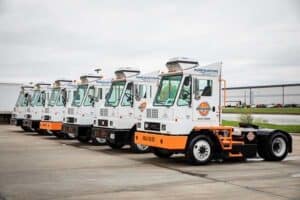Fleets expand pilot programs in dock and yard settings, citing fuel savings, emissions reductions, and popularity with drivers.
As reported by Ben Ames in DC Velocity, November 2, 2022:
Shuttling trucks and trailers to warehouse doors is a noisy job, with the rumble of heavy diesel engines running as a backdrop to the occasional thump of container doors, loading ramps, and lift trucks.
But if recent automotive manufacturing trends continue, dock and yard operations may soon start to grow just a bit quieter. Steady advances in clean-power technology are opening a new front in the quest to optimize operations, as companies begin to replace their diesel-powered yard trucks with electric vehicle (EV) equivalents.
The shift to electric power for trucks of all types is still in its early days, so few facilities have converted their entire fleets over to electricity. One reason is cost. The upfront cost of a battery-powered over-the-road truck, for example, typically far outweighs the cost of one with an internal combustion engine. Although EV proponents say that premium can be offset by government rebates or recouped through fuel and maintenance savings, those benefits take time to accrue.
Another factor limiting the widespread adoption of electric trucks is range. For instance, battery-powered Class 8 trucks today have less than one-quarter the range of a diesel version, making them a poor fit for long-haul routes covering hundreds of miles. Although manufacturers could add extra batteries to extend that range, the added weight would reduce the vehicles’ payload capacity, reducing their benefit.
But the restrictions that have inhibited the deployment of electric trucks on long-haul routes don’t necessarily apply to vehicles that are used strictly for short-distance moves—vehicles many now see as a strong fit for dock and yard work.
HOME, HOME IN THE YARD
As for what makes them a strong fit, electric units offer a number of advantages. For one thing, yard trucks—also called terminal tractors, spotter trucks, or yard jockeys—often run 16 or 24 hours per day with fresh drivers behind the wheel for each shift. That extended use pattern means that the fuel savings add up quickly with electrics, a huge plus at a time when fossil fuel prices have gone through the roof.
And because they tow trailers and containers within the confines of a dock, yard, or intermodal facility, an electric yard truck never strays far from the electrical charging infrastructure needed to refresh its batteries, reducing the likelihood it will run out of juice and become stranded.
Reading, Pennsylvania-based Penske Truck Leasing cited both those strengths when it announced earlier this year that it was adding new electric terminal trucks to its U.S. rental fleet for use in applications requiring short-distances moves—such as trailer-handling operations in truck yards, warehouses and distribution centers, and container terminals.

Penske ordered those vehicles from Orange EV, a Kansas City, Missouri-based manufacturer of heavy-duty electric vehicles. In the right applications, Penske said, those EVs could deliver benefits such as zero tailpipe emissions, the ability to operate up to 24 hours on a single charge, and a 50% shorter stopping distance than standard trucks thanks to regenerative braking systems that use the vehicle’s momentum to recharge its batteries.
“Yard vehicles are a great opportunity for electrification,” says Patrick Watt, vice president for alternative vehicle and emerging technology at Penske Truck Leasing. “They have lower road speeds so they need less energy, they have proximity to charging equipment, and their performance allows drivers to operate in most circumstances,” an improvement over earlier EV models that lacked the strength to compete with diesel, he explains.
Those attributes also make battery-powered yard trucks a strong option for companies that are trying to cut greenhouse gas emissions and shrink their carbon footprint, Watt says. On top of that, these vehicles are ready for deployment right now, he adds. “We’re early in the transition to electric vehicles [in over-the-road applications], so we’re continuing to see advancement of the technology. It’s going to be a much better, more efficient vehicle in 10 years,” Watt says. “But for an electric yard tractor, the technology you see today will continue to be effective for a long, long time.”
Another reason Penske is investing in electric yard tractors is that the electric design has proved popular with yard workers, according to Watt. “We’ve gotten positive driver feedback,” he says, noting that drivers prefer quiet battery-powered models over “sitting in a diesel vehicle that’s idling loudly, [spewing] out emissions, and vibrating more [than] an electric truck. It’s similar to an electric golf cart; it’s a pleasant environment to sit in as you wait for your next shift.”
But even more important is the fact that electric yard trucks have shown to have high rates of uptime, proving resistant to mechanical breakdowns and requiring only short, frequent recharging sessions to keep their batteries powered up. “People think about running the battery cell all the way down and then charging it all the way back up, but with just 15 to 20 minutes of charge at every opportunity that’s a natural break [for the driver], you’ll never have to worry about running it down to zero,” Watt says. “That’s a change of mindset for people who are used to thinking about diesel in miles per gallon or in gallons per hour of operation.”
STAYING OUT OF THE REPAIR SHOP
Avoiding breakdowns and delays is a big selling point for electric yard trucks, agrees Zack Ruderman, vice president of sales and marketing at Orange EV, which currently has some 500 heavy-duty electric yard trucks operating in 130 fleets across 28 states, Canada, and the Caribbean. (The company recently expanded its yard truck rental program to include electric spotter vehicles in 48 states.)
“The market says that their biggest pain point is downtime [when trucks need repairs],” Ruderman explains. “To rent a replacement truck on short notice is expensive in this market. Keeping extra trucks on site is expensive too. But you need the uptime because [yard handling is] a mission-critical operation.”
To keep downtime to a minimum, Orange says its battery-powered trucks can be recharged when the driver is taking a break anyway. As Penske noted, that recharging time adds up fast over lunch periods and 15-minute breaks during shifts.
Additional uptime comes from avoiding long stays in the repair shop, Ruderman says. Orange EV claims that battery-powered trucks break down less than diesel models. Plus, they lack components like engine transmissions, emission control units, and radiators that are time-consuming (and costly) to maintain.
They’re also designed for versatility. Orange EV says its base model can do 70% of all the jobs a diesel model can do, falling short only for the 10% of jobs that involve steep hill grades and the 20% that demand high speeds. To fill those gaps, the manufacturer plans to launch a stronger “port truck” version with greater speed and power in 2023. “Within three years, more than 50% of new yard truck orders will be EVs. Yard trucks are leading the electrical transformation,” Ruderman says.
STAYING POWER
Ruderman may be right. Companies across the supply chain have been testing electric yard trucks in recent years, and they apparently like what they see. The result has been a rapid increase in production and sales of battery-powered trucks for dock and yard management duties.
Many of those users initially chose electric models for environmental reasons, such as greening up their operations or meeting corporate environmental, social, and governance (ESG) goals. But pilot tests have given them extra reasons to continue using electric yard trucks, as they have found additional benefits in fuel savings, extended uptime, and driver satisfaction.
As electric truck production reaches new levels of maturity, the sector is primed for quick growth in the coming years. And much of that growth will likely take place in an often-overlooked corner of the logistics sector, the trailer and container yard outside your local DC.
Published: November 2, 2022/DCVelocity/

